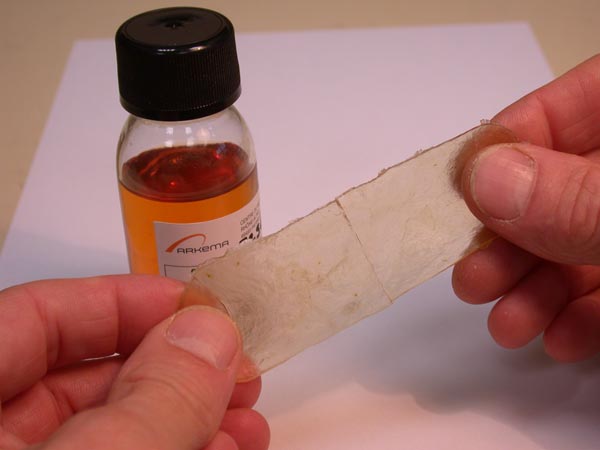What is Dielectric Elastomers ?
Dielectric elastomers (DEs) are smart material systems which produce large strains (up to 300%) and belong to the group of electroactive polymers (EAP). Based on their simple working principle dielectric elastomer actuators (DEA) transform electric energy directly into mechanical work.
A blind person uses the dielectric elastomer EAP based refreshable Braille display developed at Sungkyunkwan University, South Korea. Credit: HR Choi, Sungkyunkwan University, South Korea.
DE are lightweight, have a high elastic energy density and have been investigated since the late 90’s. Many potential applications exist as prototypes. Every year in spring a SPIE conference takes place in San Diego where the newest research results concerning DEA are exchanged.
For the elastomer often silicones and acrylic elastomers are used. In particular, the acrylic elastomer VHB 4910, commercially available from the company 3M has shown the largest activation strain (300%), a high elastic energy density and a high electrical breakdown strength.
Basically, the requirements for an elastomer material for DEA are :
- The material should have a low stiffness (especially when large strains are required)
- The dielectric constant should be high.
- The electrical breakdown strength should be high.
ELECTRONIC MUSCLE: Passive dielectrics are a variant of artificial muscle activated by the movement of electrons.
A possibility to enhance the electrical breakdown strength is to prestretch the elastomer film mechanically. Further reasons for prestretching the elastomer are the following :
- The thickness of the film decreases. A lower voltage has to be applied to obtain the same electrostatic pressure;
- The prestrain avoids compressive stresses in the film plane directions which might be responsible for failure.
- The elastomers show a visco-hyperelastic behavior. Models which describe large strains and viscoelasticity are required for the calculation of such actuators.
Several different types of electrodes are used in the research (e.g. graphite powder, silicone oil / graphite mixtures, gold electrodes, etc.). The electrode should be conductive and compliant. The compliance of the electrode is important in order that the elastomer is not constrained mechanically in its elongation by the electrode.
Temperature-responsive polymer
A temperature-responsive polymer is a polymer which undergoes a physical change when external thermal stimuli are presented. The ability to undergo such changes under easily controlled conditions makes this class of polymers fall into the category of smart materials.
RESPONSIVE POLYMERS - Polymer time-temperature indicator comprising a chromogenic dye.
There has been extensive research in the applications of intelligent polymers for use as stationary phases, extraction compounds, surface modifiers, drug delivery, and gene delivery. Contrary to the behavior of most compounds in aqueous solutions, polymers that exhibit LCST behaviour become less soluble (more hydrophobic) in water at elevated temperatures.
Thermocouples are simple electric circuits used to measure temperatures owing to the voltage generated by temperature differences at the junctions formed by two dissimilar wires or semiconductors. They can also be used to generate: a, electrical power, or b, cooling. The efficiency of energy conversion is determined more by the properties of the thermoelectric materials (here the n-type and p-type semiconductors) than by the geometry. c, State-of-the-art thermoelectric devices can contain up to several thousand individual thermocouples. The electrical and thermal characteristics can be tailored to specific applications by adjusting the number of thermocouples in series and by varying geometric factors. The new thermoelectric materials developed by Venkatasubramanian et al.1 are a major step towards more widespread use of thermoelectric technology beyond existing niche applications. (Graphics courtesy of S. Williams)
This also does not apply to any polymer, for instance dissolving polyethylene oxide or polyethylene glycol (PEG) in water requires elevated temperatures and stirring for significant time.In neutral pH and without spiking with ionic compounds PNIPAAm undergoes a phase transition from soluble to insoluble at 32 °C. Under LCST, the hydrophilic surfaces of polymer chains interact with water and are elongated.
You might also like
| Smart Materials : Self-Healing Materials What is Self-Healing Material? Self-healing... | Advanced Energy Materials : Supercapacitors ! What is Supercapacitor ? The supercapacitor,... | Smart Materials What are Smart Materials ? Smart materials are... | What is Nanoelectronic ? Nanoelectronics - a Definition Nanoelectronics... |


 Alloy Suppliers
Alloy Suppliers
 Aluminum
Aluminum
 Aluminum Extrusions
Aluminum Extrusions
 Copper-Brass-Bronze
Copper-Brass-Bronze
 Nickel
Nickel
 Magnets
Magnets
 Stainless Steel
Stainless Steel
 Stainless Steel Tubing
Stainless Steel Tubing
 Steel Service Centers
Steel Service Centers
 Titanium
Titanium
 Tungsten
Tungsten
 Wire Rope
Wire Rope